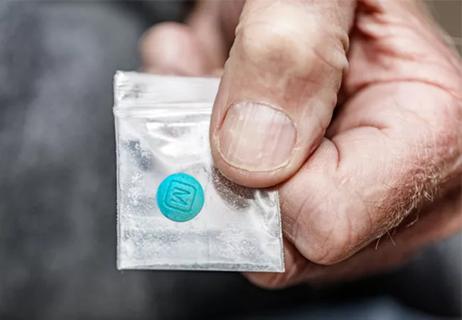Two NIH grants are looking at developing new antidotes against fentanyl overdose

When it comes to reducing the toxicity of opioid overdoses, one of the critical objectives is preventing and treating opioid-induced acute ventilatory depression. Although there is currently no better antidote to fentanyl and other opioids overdoses than naloxone (Narcan), its use has some limitations in certain clinical situations, such as in the post-operative setting, when treating pain is critical.
Advertisement
Cleveland Clinic is a non-profit academic medical center. Advertising on our site helps support our mission. We do not endorse non-Cleveland Clinic products or services. Policy
“Naloxone will get rid of a patient’s respiratory depression, but it also suppresses the analgesic effects of the opioids agent, so you’re kind of stuck,” explains Philippe Haouzi, MD, a pulmonologist in Cleveland Clinic’s Respiratory Institute. “For example, in patients with obesity hypoventilation syndrome or chronic respiratory disease who are coming out of surgery, you may need to use opioids to produce a strong analgesia, but there is a severe risk that the patient’s condition could lead to ventilatory depression.”
To overcome this challenge, Dr. Haouzi and his team have been trying to develop antidotes that only eliminate the respiratory depression effects of opioids, without interfering with their other effects. Dr. Haouzi has been awarded R33 and R21 grants from the National Institutes of Health to propel this research.
Dr. Haouzi and his team have focused their research on the effects of alpha-2 and kappa opioid agonists. He explains that his research team has shown that these two agents suppress skeletal rigidity caused by fentanyl and kappa agonists can also restore breathing without affecting the other effects of fentanyl.
“Fentanyl and other opioids have this strange effect of producing skeletal rigidity, and this rigidity of the respiratory muscles, combined with the central depression in breathing shared by all mu opioids, can make it almost impossible for the patient to breathe,” he explains. “We aren’t sure where exactly in the brain this rigidity is produced, but we know the brainstem is involved. We also know that neurons producing these effects, as well as those regulating breathing, are under the control of both alpha-2 adrenergic and kappa-opioid pathways, which can antagonize the specific effects of opioids. Our research is trying to demonstrate the efficacy of these agonist agents, which are already used clinically for other indications. Our objective is to expand their indications to opioid overdose in certain clinical settings.”
Advertisement
Dr. Haouzi joined Cleveland Clinic less than 10 months ago. “When I came to Cleveland Clinic, we had to rebuild the entire infrastructure of an in vivo lab so that we could resume this research activity. This research requires specific types of equipment that I brought with me. It is now taking place in the Department of Neurosciences at Lerner Research Institute, directed by Bruce Trapp, PhD. Yet this activity must also be combined and reconciled with my clinical activity as a physician and the medical director of the FT laboratories in the Department of Pulmonary Medicine” explains Dr. Haouzi.
He continues, “I have had, from Day 1, unconditional support from the leadership of both the Respiratory Institute and the Department of Pulmonary Medicine, Raed Dweik, MD, Daniel Culver, DO, as well as from the leadership of Lerner Research, Serpil Erzurum, MD and her teams, who have been instrumental in the pursuit of this new NIH funded research activity. My research assistant, Tristan Lewis, and I have been able to get everything operational again within a few months, and we also expect to bring on more collaborators and technicians on soon.”
The research is presently in the pre-clinical stage, and Dr. Haouzi adds that, “we are collaborating with colleagues at Case Western Reserve University but also in various institutions in the U.S. and in Europe on these projects.”
Dr. Haouzi admits that the team wasn’t expecting the response of kappa agonists to be so clear, and the stimulation of breathing induced by the kappa agonists was also unexpected.
Advertisement
“We have been pleasantly surprised by the magnitude of the effect of kappa agonists,” says Dr. Haouzi. “The data that we have accumulated so far are very promising. Everything should be easily transferable to patients, but it will still require a lot of validations and eventually will need to get FDA approval for these new medications.
How these medications will be used remains difficult to establish for now. Still, indications could certainly include patients after surgery with breathing depression under opioids, or addicted patients who are at risk of withdrawal, as long as there are no life-threatening signs.
Dr. Haouzi emphasizes that “We should keep in mind that, naloxone remains the treatment of choice of opioid, including fentanyl overdose, for the moment. Naloxone must be administered with no delay, even at large and repeated doses, with CPR maneuvers and ventilatory support if needed, whenever signs of opioid overdose or intoxication are present until new medications have shown that they can be used safely and with clear indications.
Advertisement
Advertisement

Urine test strips and point-of-care testing may be key to slowing opioid epidemic

Clinical judgment is foundational to appropriately prescribing

Expert urges action to mitigate the tragedy of fatal overdose

Cleveland Clinic study points to need for new strategies to curb addiction relapse

Study sheds light on how clinicians addressed their patients’ pain and insomnia during the pandemic

A public health tragedy with persistent pathophysiological and therapeutic challenges

Reducing prescriptions may help keep unused medication out of the community

New breakthroughs are shaping the future of COPD management and offering hope for challenging cases